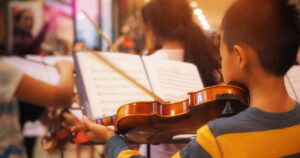As a Hal Leonard company, we are proud to endorse this Arts Education is Essential statement with over 50 national organizations:
It is imperative that all students have access to an equitable delivery of arts education that includes dance, media arts, music, theatre, and visual arts that supports their educational, social, and emotional well-being, taught by certified professional arts educators in partnership with community arts providers.
Teaching and learning will never quite be the same in our post-COVID-19 world. However, our commitment to provide rich and varied educational experiences remains unwavering. The arts have played an important role in these tumultuous times and will continue to do so for all students, including the traditionally underrepresented, those with special needs, and from low-income families. Here’s why:
Arts education supports the social and emotional well-being of students, whether through distance learning or in person.
Self-awareness, self-efficacy, self-management and perseverance, social awareness and relationship skills are central to any arts education activity, no matter the age and ability of the student or the environment in which the learning takes place. The arts, with their strong emphasis on team-building and self-reflection are supremely suited to re-ignite students’ interest in learning through collaboration, while simultaneously fostering creativity, critical thinking, and communication.
Arts education nurtures the creation of a welcoming school environment where students can express themselves in a safe and positive way.
Celebrating our ability to come together as educators and students is vital to creating a healthy and inclusive school community. The arts, through a rich partnership among certified arts educators, teaching artists, and community arts providers, play a valuable role in helping students and their families build and sustain community and cultural connections.
Arts education is part of a well-rounded education for all students as understood and supported by federal and state policymakers.
As defined in ESSA, “music and the arts” are part of a well-rounded education. Every state in the nation recognizes the importance of the arts as reflected in rigorous PreK-12 state arts standards. Forty-six states require an arts credit to receive a high school diploma, and 43 states have instructional requirements in the arts for elementary and secondary schools. As noted in Arts Education for America’s Students: A Shared Endeavor: “An education without the arts is inadequate.”
The healing and unifying power of the arts has been evident as the COVID-19 pandemic swept the country. We have
seen and heard it play out through works of art on sidewalks, shared musical moments from porches, in plays and dance performances, and every other imaginable iteration of art making. As states and schools work through multiple challenges in the years ahead, arts education must remain central to a well-rounded education and fully funded to support the well- being of all students and the entire school community.

